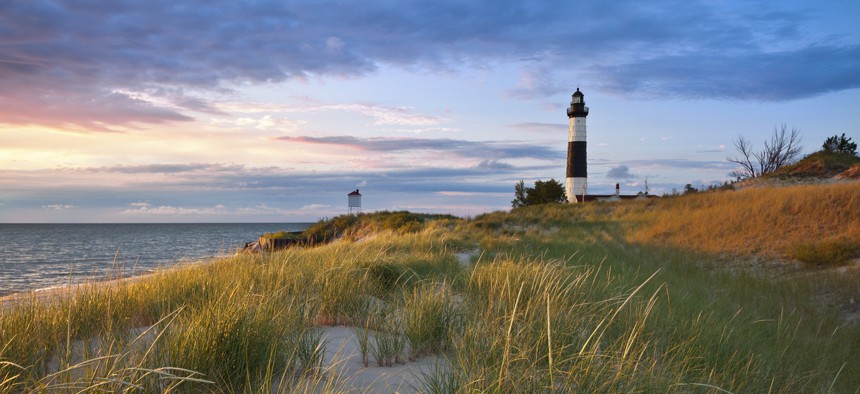Rising Waters Threaten Great Lakes Communities

Rising lake levels have caused significant damage throughout the Great Lakes, and experts say climate change is rapidly altering the shoreline. Shutterstock
“You have built in a place that’s naturally giving into the lake.”
Along a shoreline that stretches farther than the combined length of the Atlantic and Pacific coasts, waters driven by climate change have risen as much as 6 feet in less than a decade, washing away houses, destroying roads and threatening critical infrastructure such as water treatment plants in towns large and small.
The ongoing disaster striking the coastal communities of the Great Lakes hasn’t captured national attention like hurricanes and wildfires in other parts of the country. But from Duluth to Chicago to Cleveland to Buffalo, leaders are reeling from untold billions in damage — and the prospect that climate change will make things worse in the years to come.
In the eight Great Lakes states, officials at every level along 4,500 miles of coastline are scrambling to save what they can from the rising water, competing for scarce state and federal dollars and rubber-stamping permits to build private seawalls at an unprecedented pace.
Scientists say the only long-term solution, as climate change causes erosion and higher highs — and lower lows — in lake levels, is to retreat from the shoreline. But few in the region are willing to have that conversation.
“People are always looking for a technical fix so they don't have to change the way they're behaving,” said Paul Roebber, an atmospheric science researcher at the University of Wisconsin at Milwaukee.
There are no easy answers. Communities don’t have the money to buy out properties that are threatened by the lakes — especially as they try to save their own infrastructure — and there’s little appetite to use public money to help private landowners. But without a government-backed plan to retreat from the eroding coast, property owners have a legal right to defend their homes and continue armoring the shoreline.
“The best solution is to start planning ahead and basically put shoreline property owners on notice,” said Dick Norton, a professor of urban and regional planning at the University of Michigan. “‘You have built in a place that's naturally giving into the lake. There will come a time that you need to pick up your structure and move it back.’ It's easy to talk about in theory, but it's really hard to do in practice.”
Up and Down
Water levels in the Great Lakes have always fluctuated, rising and falling in years-long patterns. But those complex natural cycles are changing. Over the past five years, the region has seen massive amounts of rainfall. Even before that surge, the basin had a 10% increase in precipitation since 1900.
But warming temperatures — and dwindling ice cover during the winter — can also speed up and prolong evaporation cycles. In other words, climate change is turning up the dials on the factors that both increase and decrease water levels, making the shoreline much more volatile as tens of trillions of gallons come and go.
When the Great Lakes reached record lows in 2013, many thought the depleted lakeshore would be the new normal. Now, with houses teetering and roads flooded, they’re waiting for the day the water recedes again.
“We're starting to recognize that if we can go from record low to record high in six or seven years, we have to adjust our thinking,” said Deanna Apps, a scientist with the Detroit District of the U.S. Army Corps of Engineers.
Hanging On
While climate experts are working to understand the long-term implications of the increasingly volatile Great Lakes, most coastal communities are just trying to make it through the year.
The water treatment plant in Ludington, Michigan, once 100 feet from the shoreline, is now just 8 feet from the breaking waves of Lake Michigan. If the plant is swamped, the city would lose its water supply. The city also needs to repair an intersection that’s flooded so frequently it’s been closed for a year, and there are several private properties that are threatened.
“It would be a third of our total budget for the year just to deal with the issues we know of right now,” said city manager Mitch Foster. “That's not realistic. We’re assuming the worst, that these [water] cycles are going to be short, aggressive and extreme, but at the same time these immediate issues are so massive that trying to figure out the ancillary impacts is a tough chore.”
Two hours south of Ludington, South Haven is looking at a $20 million price tag to save its wastewater and water filtration plants, a crucial drawbridge, a river walkway and the city marina. With an annual budget of $48 million, it’s unclear how the city will find money to make the repairs.
“There’s no great plan,” said Kate Hosier, city manager. “The plan is to see what we can fix at the moment and deal with it if the money's there.”
Sheboygan, Wisconsin, is looking at costs of more than $30 million to replace water intake and sewer lines near Lake Michigan. Lake County, Ohio, needs $20 million to $30 million in erosion control work on public and private land along Lake Erie. Duluth, Minnesota, has seen $26 million in damage as storms on Lake Superior have struck the city’s signature 8-mile lake walk and water treatment plant.
“It's hard for me to provide all of the essential city services and also be moving the needle on a really expensive undertaking like climate change,” said Duluth Mayor Emily Larson, a Democrat. “So many communities are stuck band-aiding and doing their best, because no one has set the table to talk about it honestly.”
In fact, no one even has a ballpark figure for the ongoing high-water damage throughout the Great Lakes. Across state and city jurisdictions, leaders are grappling with their own problems as best they can. But no one has yet convened all parties to get a comprehensive view of the scale of the damage — let alone the number of roads, water plants, houses and parks that could be in danger in decades to come. A federal study that was supposed to provide that assessment has been stalled for several years because of a lack of funding.
“This is where the layers of government are letting us down,” said Dan Gilmartin, executive director of the Michigan Municipal League, a nonprofit association of local communities and their leaders. “We need a larger scale focus on this that typically has come from the feds and often through the states.”
Gilmartin’s group surveyed three dozen communities in Michigan and found $70 million in needed repairs. The Great Lakes and St. Lawrence Cities Initiative, a coalition of 131 mayors in the region, has pulled together its own estimate of costs to local governments in the U.S. and Canada. The group says its members are spending more than $450 million on short-term fixes, with another $865 million needed for future planning and mitigation.
Those figures don’t include costs on state, federal and private land, which make up most of the lakeshore. Fewer estimates exist for the damage across those lands, but most agree that it’s well into the billions of dollars.
National Park Service sites along the lakes have seen campgrounds, docks and parking lots submerged. State roads and parks have suffered extensive damage. And thousands of homeowners on beaches and bluffs are watching the water come closer and closer to their back porch.
In a study published in 2000, long before the volatile lake levels of recent years, the Federal Emergency Management Agency found that 16,000 structures along the Great Lakes would be susceptible to erosion by 2060.
“There does not seem to be a coherent conversation about this,” said Foster, the Ludington city manager. “It’s too much of a patchwork approach.”
Not Enough Money
Water levels on the Great Lakes have begun falling ever so slightly, as they typically do during the fall, although erosion is likely to continue as winter storms pound the lakeshore. As leaders and residents hang on by their fingernails, no one has a clear idea of the scale of the damage, let alone where the money will come from to fix it. Cities say they’re trying to cobble together state and federal funding where they can, but not nearly enough is available.
“It is exhausting to take what is a known need and try to patch it together with every single funding opportunity,” said Larson, the Duluth mayor. “So much human capital is being spent on a patchwork approach to something that is imminently dangerous. We need something that is more consistent.”
The COVID-19 pandemic has slashed city and state revenue, making the necessary investments even less likely.
“Some communities are going to be pulling back on investing in projects that were on the books because they have to fund their operating expenses,” said Mike Vandersteen, the Republican mayor of Sheboygan, Wisconsin, and chair of the Great Lakes and St. Lawrence Cities Initiative.
Several leaders complained that the Federal Emergency Management Agency hands out huge sums of money to help communities rebuild from disasters but does not provide the same funding to prevent imminent destruction from happening.
“We need the relief to come before the treatment plant is overwhelmed and leaks into the water or the road floods and cuts off emergency access,” said John LaMacchia, assistant director of state and federal affairs for the Michigan Municipal League.
Ronda Wuycheck, coastal program manager at the Michigan Department of Environment, Great Lakes and Energy, said the state has not been able to access FEMA funding for high-water damage, unlike the states hit by Superstorm Sandy in 2012. She said the federal government should make money for flood-damage work available through the Great Lakes Restoration Initiative, a $300 million annual fund that has traditionally focused on cleaning up pollutants and curtailing invasive species.
Armoring the Shore
While cities say they’re not getting the help they need, some states have at least taken steps to help homeowners. In Michigan, where 80% of the shoreline is privately owned, state and federal regulators have seen a surge in shoreline protection permits from residents who want to build seawalls.
Through the third quarter of 2020, nearly 1,800 applications had been submitted. That’s quadruple the amount for the same period of 2019, when the lakes were already hitting record levels. The permits must be approved by both the state and feds, who have worked to cut the turnaround time from 60 days to 10.
“We're just barely keeping our head above water,” said Don Reinke, who heads compliance and enforcement with the U.S. Army Corps of Engineers’ Detroit District.
Ohio has a similar percentage of private shoreline along Lake Erie. Amid a dramatic increase in calls for help, the state has cut its permitting process for shoreline protection from three to five months to about a week.
But experts say the rush to armor the shoreline is exactly the wrong approach. Seawalls perpendicular to the shoreline trap sand and compound the erosion problem elsewhere. Those parallel to the shore can multiply the force of the waves, causing the same problem. In other words, efforts to stop erosion simply redirect erosion elsewhere, creating a need for even more armor.
“The more protection you put in, the less sand is available to the system,” said Scudder Mackey, chief of Ohio’s Office of Coastal Management. “You're cutting off the sediment supply that creates and maintains the beaches. We're in a vicious cycle.”
Regulators know these structures are making the problem worse, but they have little choice but to rubber-stamp an application when a home is threatened.
“Because a landowner has the general right to protect property from erosion, applications get favorable consideration,” Reinke said. “Our regulations pretty much instruct us not to tell people, ‘Sorry, you have to pick up and move your house.’”
Breaking the Cycle
Experts say the biggest disaster in the long run may be the human “fixes” being installed today, rather than the high water itself.
“Putting in structures like seawalls and revetments [retaining walls] is not a permanent solution, because the lakes will keep pounding on them and taking them out,” said Norton, the University of Michigan professor. “You're buying in for a lot of ongoing cost, and there's no engineered solution that works without destroying the beach.”
Shoreline protection structures can cost $1,000 to $4,000 per foot, and their lifespan is typically 25-30 years — assuming conditions don’t change. Leaders acknowledge they’re on an unsustainable course, but as they work to save properties in the near term, no level of government has taken responsibility to blaze the path out of the armoring cycle.
Norton noted that many lakefront properties are owned by wealthy and politically connected residents, who are important to a city’s property tax base. That makes it difficult for small, cash-strapped towns to make unpopular decisions on whether such development is sustainable. He added that there’s little appetite to work on solutions when lake levels go down and the threat is less imminent.
Only a few cities in the basin have limited development along the shoreline. One of them, St. Joseph, Michigan, has blocked new construction within 200 feet of Lake Michigan along part of its shoreline. The ordinance passed during a low-water period in 2012, after one home was built on the edge of the lake. Neighbors complained that a proposed seawall to protect the home would cause erosion on their properties, and many were relieved to see the city put a stop to such unsustainable development. Still, some raised objections that the change infringed on the rights of property owners to build on their own land.
In some parts of Michigan, the state says there’s irrefutable data that the lakeshore is moving inland. And while it’s providing guidance to communities about the unsustainable course they’re on, the state maintains it’s the responsibility of each city to set its own development rules.
“We are looking at a potential of higher highs than we’ve known in the past,” Wuycheck said. “We are trying to tell communities they need to take these scenarios into account when they make [development] decisions. [But] local government is where we believe wise management should happen.”
Local governments say they’re looking at changing their guidelines, but given their limited expertise and resources, they need states to play a bigger role.
“Zoning can be strengthened, but zoning is frequently challenged by developers,” said Hosier, the South Haven city manager. “If there was a more solidified message from [the state], that would help.”
There’s even less political will to address existing properties in the path of the advancing shoreline. Duluth’s Park Point neighborhood is among those threatened by the high waters, but Larson said residents are not yet ready to discuss retreating from the area — nor does the city have the money to buy out 3,000 homes. But the alternatives aren’t much better.
“What's hard about climate change is the anticipation of what comes next,” Larson said. “There is no amount of system we can put in place that feels like it will eventually be enough. I cannot bully Mother Nature into behaving.”
Many other Great Lakes leaders offered similar thoughts, saying a buyout plan would be political suicide, as well as a futile effort without the money to back it up. Still, experts say the least costly long-term solution — for both the landscape and local budgets — is to retreat and allow a “living shoreline” that fluctuates with the lakes.
“What's the plan for a resilient shoreline, not one that can resist the damage but one that lives with the lakes?” said Joel Brammeier, president and CEO of the Alliance for the Great Lakes, a Chicago-based nonprofit that works to protect the lakes. “That's the elusive goal that not a lot of people are talking about, because it leads to uncomfortable places. The alternative is walling up the sides of the lake. That's not workable and it's not healthy for the Great Lakes.”
Alex Brown is a staff writer for Stateline.
NEXT STORY: Census Bureau Says Will Now End Count on Oct. 5





